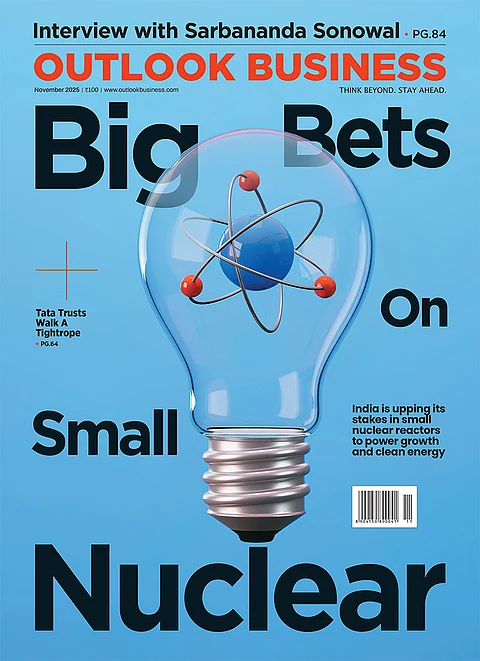$1 trillion. That is the projected size of India’s SaaS (software as a service) industry by 2030 as per a recent report by McKinsey and SaaSBOOMi.
Along similar lines, the Chiratae-Zinnov India SaaS report for 2022 stated that by 2026, the Indian SaaS market will generate $100 billion in sales and that India may even pip China as the world's second largest SaaS nation in the next few years.
There was another report by Bain & Company, the India SaaS Report 2021, which said that Indian SaaS companies are poised to capture an 8-9 per cent share of the global SaaS market.
These predictions are not just on paper. How else can the segment bagging the maximum number of deals—143 deals valuing $3,036 million—this year, despite the much-talked-about funding winter, be explained? Last year, too, with 246 deals valuing $3,918 million, it was a top scorer which also means that the per deal value has only gone up for the SaaS segment this year.
If minting unicorns is an indicator of a sector doing robustly well, of the total 18 unicorns that the country saw this year, SaaS has birthed six. In total, India now has 16 SaaS unicorns.
Freshworks becoming the first Indian SaaS company to get listed on Nasdaq in September last year did act as a huge catalyst in opening doors for many other start-ups in the same space. But, there is more that makes Indian SaaS attractive to investors, believe experts.
For example, LeadSquared, India’s newest SaaS unicorn, won purely on metrics. “LeadSquared has top decile metrics—metrics of top ten SaaS companies—lifetime value of the customer, customer acquisition cost, high retention rate, etc. When that happens, you are going to stand out among the pack of other companies and will earn capital. If you have high-quality metrics, there is potential for high growth, which will hold true if the market is large and you have a high-quality product,” says Nilesh Patel, founder and CEO, LeadSquared.
The Winning Formula
What makes SaaS attractive is its predictable revenue stream, high growth outcomes and recurring nature of business, says Ankur Pahwa, EY India ecommerce and consumer internet leader.
“Also, there are several segments and sub-segments emerging in which SaaS is becoming important. In general, a big reason also has been the overall growth in digital adoption and ecommerce which requires a lot of plug-and-play and SaaS solutions,” says Pahwa.
No wonder the space is buzzing with activity irrespective of the changing industry dynamics. The pandemic spurred the demand of SaaS products and the expansion in the number of offerings—both horizontal and vertical—in this space is a good reflection of that. Unlike a decade ago, today there is an influx of players of all sizes because of factors like increasing digitisation and demand for scalable solutions.
“Two things make SaaS click. One is that the canvas is wide enough and there are verticals underneath. To that extent, SaaS is horizontal. Underneath SaaS, there are multiple areas such as fintech, devops, etc. creating more volume and activity. Plus, businesses can be built much more frugally. Secondly, SaaS businesses can be evaluated basis the numbers, making it much more predictable,” says Ashish Fafadia, partner, Blume Ventures.
In fact, that is what gives an edge to SaaS over other segments such as fintech and edtech. “When you look at fintech, it is equivalent to regulatory tech and that can play a spoilsport in the future, depending on the way the business is being built.
A lot of challenges posed by changing regulations need to be sorted before it sees more demand. Similar factors can affect edtech, too, and added to it, there is a bit of skepticism that the world is starting to go back to in-person coaching, which I disagree with. We do not know what it will shape up into,” adds Fafadia.
So, can Indian SaaS companies take over the world? Praval Singh, vice president, Zoho Corp, answers in the affirmative. “What will define the long-term success of India as a world leader in SaaS will be our focus on R&D and developing the technical know-how. It is the foundation of building promising technology and software. Innovation has to be seen from the lens of either solving a problem that has not been solved before or by enhancing an existing solution. Homegrown companies that have R&D as an edge will help India be a leader,” he says.
Consolidation And Innovation
With the demand for SaaS products going up, there has been a surge in the number of players fighting over the same market. There is also a consolidation trend which will possibly continue with most companies either ending up getting acquired or failing to survive due to their inability to offer any differentiation.
Established players such as Zoho Corp believe that the changing dynamics and competition in the segment is good albeit with a few glitches in between. “There have been several single-product acquisitions from major players in the market in order to diversify their portfolios.
However, this often leads to an increase in the cost of the service and the customers have to pay for it. Businesses are realising that comprehensive and unified solutions offer greater value as they help avoid data silos and multi-vendor contracts. This is leading to consolidation in this space and we will see companies with diversified and unified offerings flourish,” Singh explains.
In terms of innovation, SaaS products have used the internet to entirely remove the on-site implementation. They have used smartphone apps to simplify communication and collaboration and they have used artificial intelligence to provide actionable insights and more. “India is not just building for India. India is building for the world and it is building high-demand SaaS products.
Businesses use software in all departments—sales, marketing, operations, planning, design, product, technology, etc. With such omnipresence, it is easier to see the SaaS sector growing fast and crossing $1 trillion in value,” says Iesh Dixit, founder & CEO, Powerplay, an end-to-end construction management SaaS platform. The sector, however, lacks talent for global leadership which will develop with time as more companies build from India and become global leaders, he adds.
Sanket Atal, senior vice president and managing director-sites, Salesforce India, too, is extremely bullish about the sector’s growth prospects.
“According to the Salesforce State of Connected Customer report, consumers in India estimate 60 per cent of their interactions with businesses to take place online. Additionally, 71 per cent of Indians expect companies to accelerate digital initiatives. As the world quickly moves to a cloud-based environment, there is increased adoption of SaaS in the market,” he says.
Road To Profitability
Experts believe that the desire to grow rapidly and irrationally is something that can be potentially dangerous for businesses as is the absence of a sustainable business model where profitability is not on the radar at all. Interestingly, achieving profitability is not that tough in the SaaS segment as compared to the other start-up categories. “It is the easiest for SaaS companies to be profitable because of zero marginal cost of manufacturing and distribution of software which leads to higher gross margins,” Powerplay’s Dixit points out.
There, however, has to be a roadmap to that. Zoho, which ensured it was profitable from day one, sticks to three ground rules—building a conducive and inclusive culture, a bullish focus on R&D and long-term vision and nurturing talent. “We chose to have a decentralised approach where we trickle down responsibility and accountability instead of taking away the ownership from individuals. We invest heavily in R&D to develop technological know-how and focus on skilling and retaining talent,” says Singh.
The Indian start-up ecosystem remains robust with a strong base of funded start-ups and unicorns and an increase in the number of engineering graduates and Internet users is expected to further support its growth.
However, there is still a long way to go before we become a global leader in SaaS. But, with Indian SaaS companies driving value creation by maintaining a strong annual recurring revenue-to-funding ratio in line with their global SaaS peers and creating a strong talent pool with SaaS-relevant skill sets, as per all those aforementioned reports, the segment seems set in the right direction.





























